Click here to print
Houdini Spirited from a Movie Cache
posted April 15, 2015
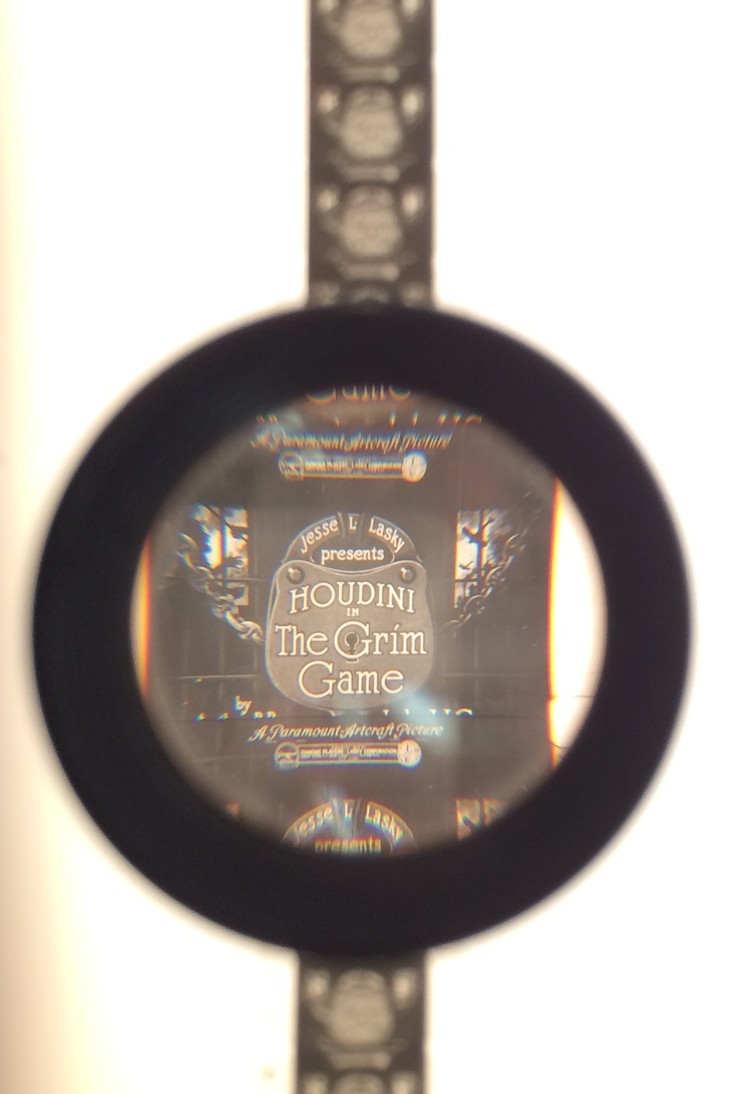 The Grim Game, one of only five films featuring Houdini, master escape artist, has reemerged — appropriately enough, from the hands of a prestidigitator.
The Grim Game, one of only five films featuring Houdini, master escape artist, has reemerged — appropriately enough, from the hands of a prestidigitator.
n
Harry Houdini won acclaim as a master illusionist and escape artist, but that he was also a film actor has generally eluded public attention.
In 1918, already in his 40s, the Hungarian immigrant to Wisconsin who had scrapped his way from lowly venues to top billing around the world expanded into film in a 15-part serial, Master Mystery. The episodes featured versions of the daredevil escapades that had made him famous.
Houdini reasoned that the medium of film could multiply his appeal. But after appearing in the serial, and then four features, the iconic entertainer abandoned the movies in 1923, saying “the profits are too meager.”
The mere fact that Houdini’s film appearances showcased Houdini has been enough to make absences from the Houdini archive keenly felt, and none more so than his 1919 feature, The Grim Game. For decades all that has been publicly available of it has been a five-minute clip that was used in newsreels because it featured the star surviving a plane crash — well, seeming to.
A major event in Houdini fandom, then, has been the emergence of the whole of The Grim Game (with perhaps a scene or two missing — whether by the producers’ original design or not seems unclear even to Houdini watchers). It is by all accounts an hour of quintessential Houdini front-and-centering.
On 29 March 2015, at Grauman’s Egyptian Theater, Hollywood’s oldest movie palace, the Turner Classic Movies Festival closed with a screening of a digital restoration of the film. On his Wild About Harry website, a clearinghouse of all things Houdini, John Cox gave the restoration a rave review, and reported that the audience of magicians, Houdini aficionados, and silent-film fans responded enthusiastically, throughout: “Houdini in The Grim Game is extraordinary in all regards,” Cox wrote. “Here we finally see the Houdini the world knew, loved, and rooted for again and again. Houdini is a superstar in The Grim Game, which is perfectly tailored to showcase his talents and plucky personality. Yes, it’s just as good as has always been rumored.”
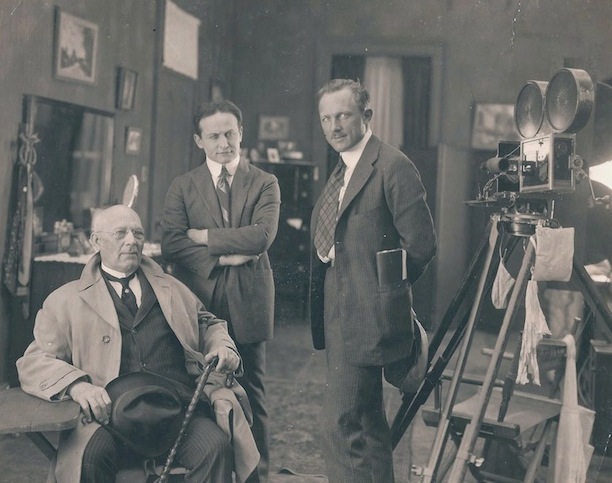
Publicity photo of Harry Houdini (center) and director Irvin Willat (right) on the set of The Grim Game, 1919. Paramount/Arthur Moses Collection / public domain
n
A copy of the full film was long thought to exist in private hands, and it popped back into public view somewhat as Houdini had done from trunks into which he had had himself perilously locked.
Fittingly, the copy emerged from the closely held collection of a prestidigitator of some renown, Larry Weeks, a self-styled “Houdini’s biggest fan,” who died 13 October 2014 in Queens, New York, at the age of 95, after amassing a large collection of Houdini archival material including most of his surviving film work — John Cox writes more about him on his Wild About Harry site. His own juggling and magic skills were enough to win him the cover of the September 1958 issue of Genii, The Conjurors’ Magazine.
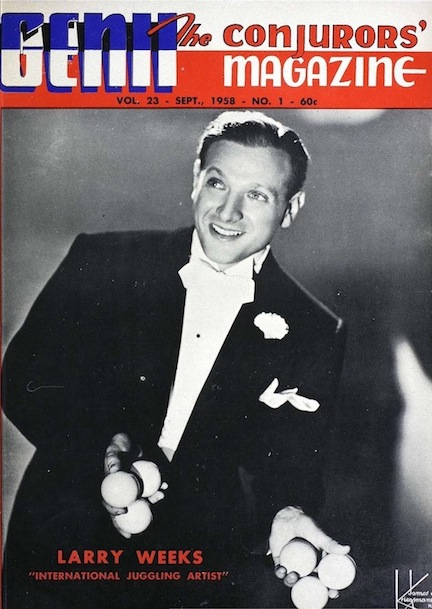
Larry Weeks on the cover of the September 1958 issue of Genii, The Conjurors’ Magazine
In 2014, Rick Schmidlin, a highly regarded film preservationist and silent-film authority, went to Weeks’s Brooklyn apartment at the suggestion of the owners of The Houdini Museum in Scranton, Pennsylvania, Dorothy Dietrich and Dick Brookz.
The film has had an odd status: not gone forever, but not particularly likely to see the light of day. Houdini experts knew Weeks had a copy, probably the only one still in existence, and had shown it privately to friends and magic and illusion insiders. Schmidlin found upon meeting him that he would be willing to part with it. The two men negotiated a fee for two cans that held five and a half reels of developed film — half a reel more than the original had been thought to include —along with two reels of film negative.
“Nothing was missing,” Schmidlin said in a statement, at the time. “The film was a complete joy to see. The Grim Game is not just a long lost film from the silent era but a really great and fun film that will surprise and entertain all.”
Accompanying the screening of the digital restoration was a live performance of a new score by Brane Živković, performed by a quartet of violin, cello, clarinet, and piano. Živković teaches film-music composition at the Maurice Kanbar Institute of Film and Television at New York University.
The restoration was “the type of dream project that first lured me into the field of film preservation,” says Kimberly Tarr, a moving-image preservation specialist and head of the Media Preservation Unit at New York University Libraries, which was among major actors in the restoration. She says: “It’s not every day that a lost film from 1919 is found, let alone one starring a man whose name has become synonymous with magic.”
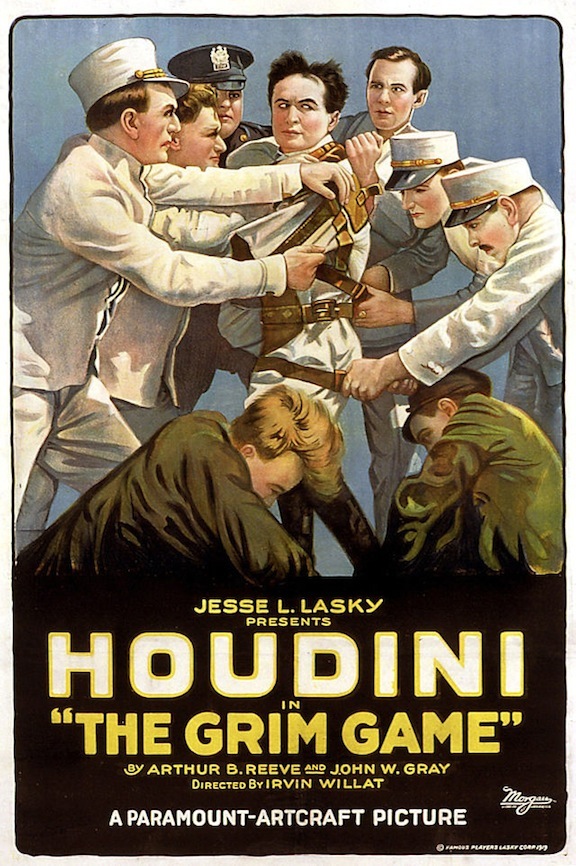
n
Of all the projects she has worked on, nothing compares with this one, “hands down,” she says. “Harry Houdini is someone who resonates with just about anyone you talk to on the streets. And the era and time in which he was performing his escapes and the symbolism of what those escapes meant for people then and people now… I’ve been so surprised by Houdini’s lasting influence.”
As far as she and Schmidlin have been able to tell, she says, Weeks originally obtained a 35mm nitrate print either from the Houdini family or with money he made in the 1940s as a juggler and magician who performed the world over. “He acquired this 35mm print, we think in the 40s,” says Tarr. “And then due to deterioration, someone suggested at some point in time that he should think about transferring it. So he transferred it to 16mm safety stock. The edge code suggests that that happened in 1959.”
She adds: “We don’t know what he did with the nitrate,” which was a volatile format that collectors were advised not to store unless they could do so in ways that discouraged it to burst into flames. “He had a 16mm inter-negative and a 16mm positive that he made from that.
“So we were able to work with those two elements and they were in pretty good condition. There was minimal scratching, minimal projector damage. They were on acetate stock, so there was the beginning of vinegarization – acetate deterioration. So overall they were in pretty good shape.”
Still, she says, “we had to do a great deal of work on this digital file.” Restoring the film took Metropolis Post, a New York City lab, a year of concentrated work.
The film runs to just over 2000 feet, or five and one half reels. Weeks had only about two reels of negative – 800 feet. “We worked with the negative for as much as we could, and then the positive, which of course was a generation off,” says Tarr.
She and Schmidlin remain in some doubt about the precise history of the material because Larry Weeks “wasn’t very forthcoming, at times,” she says. “He really prized this; he guarded it quite well, and guarded the history around it. He came from a world in which all of his friends were magicians. He thought everybody wanted this film. He was always afraid it would fall into the wrong hands.
“So it was really exciting when he decided to make it accessible to the world.”
She and her collaborators are now in negotiations to place the restoration with other festivals, and have announced their second booking, after the Turner festival. This week, on 16 April 2015, it will be shown on the closing night of the Wisconsin Film Festival at the University of Wisconsin at Madison — an appropriate location given Houdini’s rearing in Appleton, a Wisconsin town.
The film will air on TCM in the fall. Tarr says no details have yet been finalized on a DVD release.
Houdini of Budapest… and Appleton, Wisconsin
n
Born Ehrich Weiss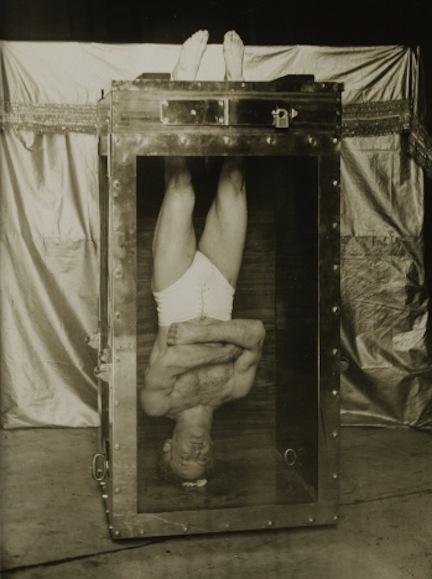 in Budapest in 1874, at four Houdini travelled with his mother and four brothers to tiny Middleton, where his father was struggling to establish himself as a rabbi. The family next moved to New York, where Ehrich Weiss, fascinated with traveling circuses, honed his skills as a contortionist and trapeze artist. From concert saloons, variety theatres, dime museums, and midways, he graduated to vaudeville theaters, and then to stages around the world, and to wealth, as Harry Houdini, renowned for such feats as his Chinese Water Torture Cell. (A recording of his intro spiels in online.)
in Budapest in 1874, at four Houdini travelled with his mother and four brothers to tiny Middleton, where his father was struggling to establish himself as a rabbi. The family next moved to New York, where Ehrich Weiss, fascinated with traveling circuses, honed his skills as a contortionist and trapeze artist. From concert saloons, variety theatres, dime museums, and midways, he graduated to vaudeville theaters, and then to stages around the world, and to wealth, as Harry Houdini, renowned for such feats as his Chinese Water Torture Cell. (A recording of his intro spiels in online.)
His grasp of publicity extended to realizing that his suitability for movies resided in their showing off his derring-do. In The Grim Game — an “offbeat adventure yarn,” in the characterization of Hal Erickson of Rovi — Houdini plays Harvey Hanford, a young journalist who is framed for the murder of his uncle and locked up. Here, writes Erickson, the plot thickens around Houdini’s fame in the arts of escape. Far from try to divorce the real-life Houdini from the hapless youth he portrays, the film’s producers, Famous Players-Lasky Corp., precursor to Paramount Pictures, made hay of his fame. Of course, he must escape, and he does: and while on the lam he pursues the crooks who set him up.
Publicity promised that fans would “see him dive between the wheels of a speeding motor-truck and find his pursuers!” and climb the side of a prison, and fight a terrifying battle with his foes on “the brink of a gorge,” and leap from a skyscraper and release himself from a straitjacket while dangling head down from a rope…
Cox exclaims: “The Grim Game is easily the best written, best directed, best shot, best acted, and best conceived Houdini movie by far. It’s clever, fun, funny at times, and the escapes are simply breathtaking!
“Director Irvin Willat also knows how to play on audience expectations. When Houdini is confined in his jail cell, the director gives us a magnificent slow reveal of the iconically chained Houdini framed in the cell doorway. It’s a perfect fusion of Houdini and cinema, and this amazing moment, conceived and shot 96 years ago, brought down the house in 2015.”
But the response was just as lively at other moments, he writes: for the “suspended straitjacket escape,” the “bear trap,” and other star turns.
C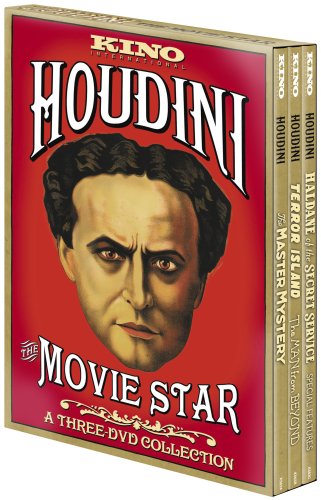 ox writes that the success of the film lies in it being the only Houdini vehicle “in which he plays an ordinary man and, basically, himself.” Far from the “movie clichés” of his other films — millionaire inventor, secret agent, man from beyond… — “here he is just Harvey Hanford, a working reporter in a realistic urban setting. He’s an underdog and an outsider, banned from his wealthy uncle’s estate and teased by his office co-workers. But he is an optimist with an infectious grin, who just happens to possess an extraordinary ability to escape from any restraint the modern world throws on him.”
ox writes that the success of the film lies in it being the only Houdini vehicle “in which he plays an ordinary man and, basically, himself.” Far from the “movie clichés” of his other films — millionaire inventor, secret agent, man from beyond… — “here he is just Harvey Hanford, a working reporter in a realistic urban setting. He’s an underdog and an outsider, banned from his wealthy uncle’s estate and teased by his office co-workers. But he is an optimist with an infectious grin, who just happens to possess an extraordinary ability to escape from any restraint the modern world throws on him.”
He is, in fact, “the essence of Houdini” and at the Egyptian the cognoscenti “completely embraced the character,” he observed — they embraced “the real Harry Houdini! Ordinary man and superman in one.”
Until now, all that virtually all Houdini fans have been able to see of the film has been a five-minute fragment. It was included in a generous 2008 Kino Lorber boxed set, Houdini: The Movie Star. Gathered from film archives and private collections, that had all of Houdini’s surviving films, except the bulk of The Grim Game, which is to say: The Master Mystery (1919, 238 minutes), Terror Island (1920, 55 minutes), The Man from Beyond (1922, 68 minutes), Haldane of the Secret Service (1923, 84 minutes), along with plenty of added features such as footage of escapes from about 1907 to 1923 and the audio of him speaking, from 1914.
The five-minute fragment from The Grim Game remained publicly available only because it showed an unscripted plane crash that, Erickson writes, “was captured on film and exploited to the hilt in Grim Game’s publicity campaign”: as a newsreel hit.
In the restoration, Cox observes, the sequence comes fully alive: Houdini’s character hangs from a rope strung between two airplanes in mid-air, and when “the famous plane crash” occurs, it “is more complete and much clearer that what has been available (you can see the plane wings shatter).”
Here, Houdini the actor and Houdini the master of publicity merge.
Houdini: limited actor, publicity optimizer
n
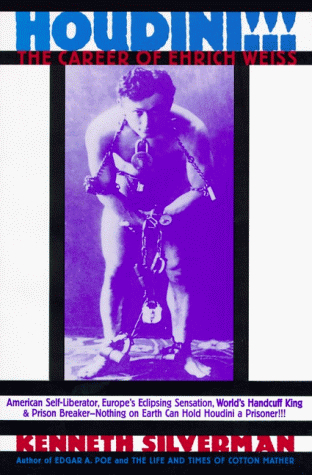 While in some senses one of the first screen action heroes, Houdini’s roles are now, by most sober critical assessments, far more memorable for their depiction of his physical feats than for any thespian skills. In a 1999 Public Broadcasting Corporation special in its American Experience series, Houdini, one of his many biographers, Kenneth Silverman, author of the acclaimed 1996 biography HOUDINI!!! The Career of Ehrich Weiss, observed: “He was a terrible actor. I mean, he has about three expressions. He can frown, he can look wooden, and he can look quizzical. That’s about it.”
While in some senses one of the first screen action heroes, Houdini’s roles are now, by most sober critical assessments, far more memorable for their depiction of his physical feats than for any thespian skills. In a 1999 Public Broadcasting Corporation special in its American Experience series, Houdini, one of his many biographers, Kenneth Silverman, author of the acclaimed 1996 biography HOUDINI!!! The Career of Ehrich Weiss, observed: “He was a terrible actor. I mean, he has about three expressions. He can frown, he can look wooden, and he can look quizzical. That’s about it.”
James “The Amazing Randi” Randi chimed in: “He didn’t mean these as comedies. He wanted to be taken very seriously. He was a great failure in the films.”
In HOUDINI!!!, Silverman assesses the star’s earliest film appearances and write that, among the “unfollowable plot and gimcrackery” of The Master Mystery, he was limited to three expressions: “pucker-lipped flirtatiousness, open-eyed surprise, and brow-knotted distress.” Small mercy, he writes, is that “closeups, many of them in profile, flatter his handsomeness, the large head and fine, medallion-like features.”
NYU’s Kimberly Tarr says she thinks such judgments harsh: “Perhaps I went into it with very low expectations, having read the critical response to him on screen. I think that sells him short. He wasn’t trained as an actor, but he had amazing charisma.” She says of one moment in the Egyptian cinema during the premiere of the restoration of The Grim Game: “During one escape he looks directly into the camera, and there was an audible gasp in the screening room.
“He really connected with audiences. I don’t think he was the top actor of his day, and he was undoubtedly older than many contemporary film stars when he stepped onto the screen, but I think he was a pretty good actor.”
He did not lack for publicity skills, however – at least, not for a hunger for their spoils.
Take that five-minute plane-crash sequence. In a newsreel that incorporated them, the claim is grand: Houdini was, it trumpeted, “the first man to be photographed changing from plane to plane in mid-air.” And now, “believing the public would like to share his most harrowing experience, Houdini presents this camera record of the only miracle ever photographed — falling 4400 feet after an aeroplane collision and escaping with life.”
Various qualified observers have had something to say about that.
In HOUDINI!!!, Silverman explains how the sequence was put together: Houdini gave way in the crucial passages to stunt pilot Robert E. Kennedy, who was lucky to escape with his life: “In the (fortunately) gliding crash-landings of the planes — wings chewed, propellers gone — Kennedy was slammed onto a newly plowed bean field and dragged to a stop, cut by stones but alive.”
{Click on an image to expand}
Silverman continues: “In talking about the sequence over the next few years, however, Houdini gradually Roosevelt-ized it, erasing Kennedy from the picture and putting himself in. At first he merely stressed to others that all the stunts had been ‘actually performed’ — without mentioning by whom. He elaborated this technical truth during promotional appearances for the film, offering a (misleading) thousand-dollar reward ‘to any person who can prove that the airplane collision was not genuine.’ The full Munchhausen was ready a year later, when he told an interviewer for Picture Show magazine ‘I was dangling from the rope-end ready for the leap. Suddenly a strong wind turned the lower plane upwards, the two machines crashed together — nearly amputating my limbs,’ etc. etc. He even improved on the harrowing-enough details, including the altitude. Autographing an eight-by-ten publicity still that showed him clutching the biplane’s wing struts — taken, however, on the ground — he wrote: ‘About 4000 feet in the air.’”
The film’s Hollywood producers took things from there and, Silverman writes, “in hooey and hype, Houdini easily found his match in Hollywood.” Publicists clamored about him being bound and manacled within a sealed canvas sack and thrown from the Eiffel Tower, only to escape so that half way to the ground he could be seen “clinging to a parachute, one which he descended.”
Don’t try that, on your next visit to the City of Light.
Ironically, Silverman notes, film diminished the magic of Houdini’s feats, which they undoubtedly had and often deserved, however hyped, because “filmed stage magic [is] indistinguishable from camera magic,” so “the movie camera robbed magicians of their power to mystify.” Silverman notes that even Houdini, later on, admitted as much when he commented “No illusion is good in a film, as we simply resort to camera trix, and the deed is did.”
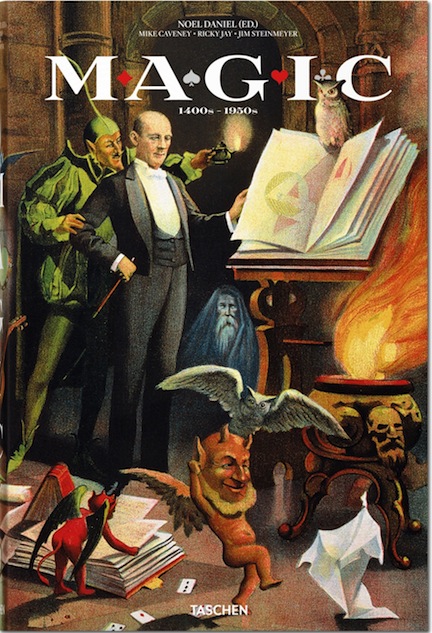 There are illusions and illusions. People had seen Houdini standing next to director Irvin Willat when the planes crashed in mid air, so Houdini wasn’t the only person who had grounds to believe that it was not he who’d survived it. “He just couldn’t stand the thought of someone else receiving the credit for surviving a death-defying accident,” says Mike Caveney, a renowned magician and author and publisher of books about magic, who was at the restoration’s premiere. “Never mind that they did and he didn’t. That’s what made him Houdini. It’s too bad that just starring in a Hollywood movie wasn’t enough for him. He had to be the top dog. In everything.”
There are illusions and illusions. People had seen Houdini standing next to director Irvin Willat when the planes crashed in mid air, so Houdini wasn’t the only person who had grounds to believe that it was not he who’d survived it. “He just couldn’t stand the thought of someone else receiving the credit for surviving a death-defying accident,” says Mike Caveney, a renowned magician and author and publisher of books about magic, who was at the restoration’s premiere. “Never mind that they did and he didn’t. That’s what made him Houdini. It’s too bad that just starring in a Hollywood movie wasn’t enough for him. He had to be the top dog. In everything.”
Calling into doubt the actions let alone motivations of a cultural icon has presumably always been a treacherous path to tread, or flight path to risk. But in a New York Times review, Teller (of Penn &) appreciated the exhaustive sleuthing of Silverman, a retired Pulitzer Prize-winning professor of English at New York University best known in those circles for his work on Cotton Mather — a witch burner whose crankery Houdini, an avid debunker of spiritualism, was unfortunately not around in 17th-century New England to test with the third degree — and Edgar Allan Poe. Teller explains that Silverman had spent almost five years poring over every record he could find “in libraries and attics all over the world,” such as scrapbooks, diaries, letters, playbills, census reports, court transcripts, thousands of press clippings in half a dozen languages, “and even the minutes of the Hebrew Relief Society.”
All to good effect, was Teller’s conclusion: “The result is a virtually all-new biography. Instead of retelling the standard Houdini anecdotes, Mr. Silverman examines the evidence with a fresh eye and a sleuthlike determination not to be snowed by Houdini’s notorious ‘improvements’ of the facts.”
Teller asks why turn-of-the-century society was “so ready to embrace a muscular little lock-picker? Here Mr. Silverman’s grasp of history shines. He sees in Houdini the epitome of three major trends of the era: spiritualism, criminology, and fitness.
“The raw material of Houdini’s act came from the stage performances of spiritualists. Typically, a spirit medium was searched, then bound or handcuffed and enclosed, along with some musical instruments, in a ‘cabinet’ of wood or cloth. Quickly the unseen medium slipped out of the restraints, raised a ruckus (‘spirit music’) and just as quickly slipped back in. When the cabinet was thrown open, all the knots or locks were found still intact, thus ‘proving’ the music was celestial.
“Houdini secularized the miracle.”
These days, for all their just-as-miraculous multiplication by publicity-conscious pontiffs, even saints don’t go unchecked. And Houdini’s reputation, among magic aficionados, as among assessors of thespian talent, is far from unalloyed.
In The Houdini Code Mystery: A Spirit Secret Solved, which appeared in 2000 (from Mike Caveney’s Magic Words limited-edition imprint), William Rauscher portrayed Houdini as less astounding and less decent than is generally held. Of course, revealing magicians’ sleight does not go down well among their fans, and Rauscher divided opinion by doing some of that. And, again, met a mixed response.
But perhaps reaching a mixed assessment of Houdini the film actor does him no disservice, if it humanizes or all-too-humanizes him the way Silverman’s biography did.
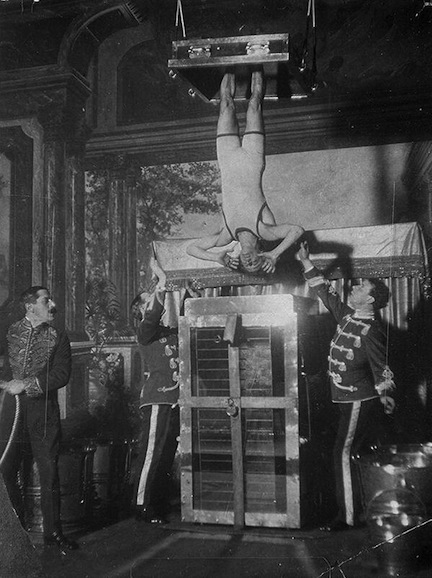 Caveney sent this assessment of the Grauman Egyptian premiere of restored The Grim Game: “Once I got over my childhood infatuation with Houdini I discovered that he was far from a great magician but was perhaps the greatest publicity hound of his era. When it came to dealing with his competitors, nothing was off limits. And his ego knew no limits. If it took the rewriting of history to enhance his image, then he rewrote history. I always imagined that the small fortune his movie studio cost him and many of his friends was due to his misguided opinion of himself as an actor.
Caveney sent this assessment of the Grauman Egyptian premiere of restored The Grim Game: “Once I got over my childhood infatuation with Houdini I discovered that he was far from a great magician but was perhaps the greatest publicity hound of his era. When it came to dealing with his competitors, nothing was off limits. And his ego knew no limits. If it took the rewriting of history to enhance his image, then he rewrote history. I always imagined that the small fortune his movie studio cost him and many of his friends was due to his misguided opinion of himself as an actor.
“Then I saw the world premier of Houdini’s recently restored The Grim Game. The first point to be made is that 90 years after Houdini died, he can still pack a theater. I was lucky to get one of the last tickets sold. I still don’t think that Houdini was a very good actor but by today’s standards, no one in this film was very good. It appears that, during the infancy of film, most people (over)-acted when being filmed.
“The script was nothing but a vehicle that allowed Houdini to escape from a variety of different restraints. And escape he did. This modern-day audience cheered every escape as if each one required super-human abilities to complete.
“It was actually thrilling to see him in these hair-raising scenes. At age 45 he could still deliver the goods.”
Caveney’s judgment is, then, thankfully not all hero worship, nor debunking, but rather it shifts about in a matrix of parameters, and he does not seek to deny that the charisma of Houdini could and indeed still does shine: “I wish he could have seen that packed house at the Egyptian Theater cheering him on and rewarding his movie with a standing ovation at the end. He would have loved that. And so did I.”
More Houdini on film?
Are more Houdini films or fragments out there? Quite possibly, says William Kalush, who wrote The Secret Life of Houdini: The Making of America’s First Superhero (2006) with “Reefer Madness” author Larry “Ratso” Sloman. (An aside: with what justification is hard to say, but their book has something of the Houdini about it: “Kalush and Sloman,” reviewer Tony Barrell wrote in the London Sunday Times, “appear to have raked through every known Houdini archive to produce the most comprehensive and controversial biography ever written about the man, with its contention that he was a spy who may have been murdered by a cult,” which almost makes you hope that Houdini might yet emerge from his final locked casket. Well, actually, that was something Kalush and Sloman did call for.)
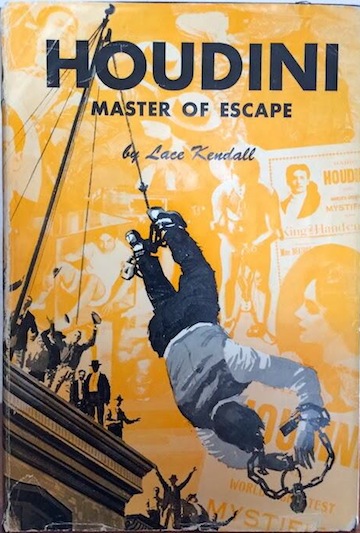 Kalush says: “There are unknown films of Houdini that turn up from time to time. I found one recently that hadn’t been seen previously of Houdini flying for the first time in Australia. I was writing a lecture on Houdini and while reading through other papers I found a sort of cease and desist letter from Houdini’s lawyer on behalf of his widow telling a film company that they could not use some footage in one of their films. But when we found that film, Houdini was in it.
Kalush says: “There are unknown films of Houdini that turn up from time to time. I found one recently that hadn’t been seen previously of Houdini flying for the first time in Australia. I was writing a lecture on Houdini and while reading through other papers I found a sort of cease and desist letter from Houdini’s lawyer on behalf of his widow telling a film company that they could not use some footage in one of their films. But when we found that film, Houdini was in it.
“I would bet there is more film of Houdini out there.”
Whether or not any was in Larry Weeks’s Brooklyn apartment along with The Grim Game remains to be seen, says NYU’s Kim Tarr. She says Weeks held The Grim Game as part of a vast collection “that his estate is still reconciling.” She is among film archivists working with the executors to see what other rare items may be in the collection. “Larry was part of the vaudeville scene, and very close to that world,” she says. “We’re not sure if everything he had was commercially available, and even if it was, if it’s still around. Or there may be other film shot by his comrades.”
But finding out may take a while, she says. Weeks left no family or relatives. And in the state of New York, probate and inheritance law could guarantee that seeing what his wunderkammer of an apartment concealed may take months, if not years.
— Peter Monaghan
Printed from Moving Image Archive News: https://www.movingimagearchivenews.org
URL to article: https://www.movingimagearchivenews.org/spiriting-houdini-from-a-movie-cache/
Click here to print























